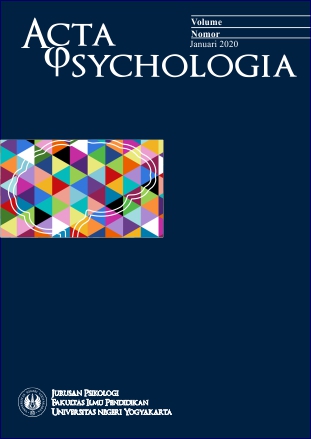Pengaruh Kepemimpinan Rendah Hati Terhadap Kelelahan Emosional Perawat Instalasi Gawat Darurat dan Intensive Care Unit
DOI:
https://doi.org/10.21831/ap.v4i2.58881Keywords:
Kelelahan Emosional, Kepemimpinan Rendah Hati, Perawat, Instalasi Gawat Darurat, Intensive Care UnitAbstract
Perawat bagian IGD dan ICU memiliki beban kerja yang berat dan tuntutan untuk melakukan penanganan secara cepat dan tepat dalam kondisi darurat sehingga rentan mengalami kelelahan emosional. Kelelahan emosional pada perawat dapat dipengaruhi oleh jenis kepemimpinan maupun sifat pemimpin. Perawat membutuhkan emotional support dari pemimpin untuk dijadikan sebagai resource sehingga meminimalisir kelelahan emosional. Emotional support dapat diperoleh melalui apresiasi dan feedback dari pemimpin. Pemimpin yang rendah hati mampu memberikan apresiasi dan teachability kepada anggotanya. Oleh karena itu, penelitian ini bertujuan untuk mengetahui pengaruh kepemimpinan rendah hati terhadap kelelahan emosional perawat IGD dan ICU. Penelitian ini bertujuan untuk mengetahui pengaruh kepemimpinan rendah hati terhadap kelelahan emosional perawat IGD dan ICU. Penelitian ini menggunakan pendekatan kuantitatif dengan jenis ex post facto. Penelitian ini juga merupakan penelitian populasi. Subjek merupakan anggota perawat bagian IGD dan ICU RSUD Panembahan Senopati Bantul yang berjumlah 42, dengan 18 anggota perawat bagian IGD dan 24 anggota perawat bagian ICU. Instrumen yang digunakan adalah Skala Kelelahan Emosional yang berjumlah 17 item dengan reliabilitas 0,890 dan Skala Kepemimpinan Rendah Hati yang berjumlah 25 item dengan reliabilitas 0,972. Analisis data yang dilakukan menggunakan analisis deskriptif dan analisis regresi linear sederhana. Hasil penelitian menunjukkan bahwa terdapat pengaruh negatif dan signifikan variabel kepemimpinan rendah hati terhadap variabel kelelahan emosional. Variabel kepemimpinan rendah hati berkontribusi sebanyak 13,9% terhadap kelelahan emosional subjek. Dalam penelitian ini, 62% subjek menilai sifat kerendahan hati pemimpin sangat tinggi dan 88% subjek mengalami kelelahan emosional berada di tingkat sangat rendah.
References
Alifandi, Y. (2016). Kelelahan Emosi (Emotional Exhaustion) pada Mahasiswa yang Bekerja Paruh Waktu. Skripsi, Universitas Negeri Malang.
American Psychiatric Association. Diagnostic and Statistical Manual of Mental Disorders (4th ed.). Washington, DC: American Psychiatric Association, 1994.
Anderson, R. E., & huang, wen-yeah. (2005). Empowering Salespeople: Personal, Managerial, and Organizational Perspectives. Psychology & Marketing, 23(2), 139–159.
Arikunto, S. (2010). Prosedur Penelitian: Suatu Pendekatan Praktik. Jakarta: Rineka Cipta.
Azwar, S. (2017). Metode Penelitian Psikologi (edisi III). Penerbit Pustaka Pelajar: Yogyakarta.
Barello, S., Caruso, R., Palamenghi, L., Nania, T., Dellafiore, F., Bonetti, L., Silenzi, A., Marotta, C., & Graffigna, G. (2021). Factors Associated with Emotional Exhaustion in Healthcare Professionals Involved in the COVID-19 Pandemic: an Application of the Job Demands-Resources Model. International Archives of Occupational and Environmental Health, 94(8).
Choi, B. S., Kim, J. S., Lee, D. W., dkk. (2018). Factors Assoociated with Emotional Exhaustion in South Korean Nurses: A Cross-Sectional Study. Psychiatry Investigation 15(7) 670-676
Collins, J. (2001). Good to Great. Why Some Companies Make the Leap... and Others Don't. New York, NY: HarperCollins Publishers.
Collins, J. (2002). Reading Guide: good to Great. New York, NY: Harper Collins. Retrieved from Harper Collins: http://www. harpercollins.com/author/authorExtra.aspx?isbn13=9780066620992&displayType=readingGuide
Cooley, S. (2016). Human Relations Theory of Organizations. In Global Encyclopedia of Public Administration, Public Policy, and Governance (pp. 1–5). Springer International Publishing. https://doi.org/10.1007/978-3-319-31816-5_2998-1
Cropanzano, R. (1998). Emotional Exhaustion as a Predictor of Job Performance and Voluntary Turnover. Journal in Applied Psychology 83(3) 486-493
Cropanzano, R., Rupp, D. E., & Byrne, Z. S. (2003). The relationship of emotional exhaustion to work attitudes, job performance, and organizational citizenship behaviors. Journal of Applied Psychology, 88(1), 160–169. https://doi.org/10.1037/0021-9010.88.1.160
Dantes, N. (2012). Metode Penelitian. Yogyakarta: CV Andi Offset.
Deery, S., Iverson, R., & Walsh, J. (2002). Work Relationships in Telephone Call Centres: Understanding Emotional Exhaustion and Employee Withdrawal. Journal of Management Studies, 39(4), 471–496. https://doi.org/10.1111/1467-6486.00300
Demerouti, E., Bakker, A. B., Nachreiner, F., & Schaufeli, W. B. (2001). The job demands-resources model of burnout. Journal of Applied Psychology, 86(3), 499–512. https://doi.org/10.1037/0021-9010.86.3.499
Farisi, S., Siswadi, Y., & Gunawan, A. (2022). Peran Mediasi Kelelahan Emosional: Kepemimpinan, Self Efficacy dan Konflik Peran terhadap Kepuasan Kerja. Jurnal Ilmiah Manajemen dan Bisnis 23(1) hal. 23-37
Gaines, J., & Jermier, J. M. (1983). Emotional Exhaustion in a High Stress Organization. Academy of Management Journal, 26(4), 567–586. https://doi.org/10.2307/255907
Ghozali, I. (2018). Aplikasi Analisis Multivariate dengan Program IBM SPSS 2 Edisi 9. Semarang: Universitas Diponegoro
Hills, Meghan E. (2014). Emotional Exhaustion: Creation of a Measure and Exploration of the Construct. Thesis, Oklahoma State University
Houkes, I., Janssen, P. P. M., Jonge, J., & Bakker, A. B. (2003). Specific determinants of intrinsic work motivation, emotional exhaustion and turnover intention: A multisample longitudinal study. Journal of Occupational and Organizational Psychology, 76(4), 427–450. https://doi.org/10.1348/096317903322591578
Hu, Z., Wang, H., Xie, J., et al., (2021). Burnout in ICU Dotors and Nurses in Mainland China: A National Cross-Sectional Study. J. Crit. Care, 62, 265-270
Ikatan Dokter Anak Indonesia. (2017). Mengenal Instalasi Gawat Darurat (IGD) dan Pediatric Intensive Care Unit (PICU) di Rumah Sakit. https://www.idai.or.id/artikel/seputar-kesehatan-anak/mengenal-instalasi-gawat-darurat-igd-dan-pediatric-intensive-care-unit-picu-di-rumah-sakit
Kemenkes. (2018). Peraturan Menteri Kesehatan RI Nomor 47 Tahun 2018 tentang Pelayanan Kegawatdaruratan
Lee, H., An, S., Lim, G. Y., & Sohn, Y. W. (2021). Ethical Leadership and Followers' Emotional Exhaustion: Exploring the Roles of Three Types of Emotional Labor toward Leaders in South Korea. International Journal of Environmental Research and Public Health, 18(20), 10862. https://doi.org/10.3390/ijerph182010862
Li, H., Cheng, B., Zhu, X. P. (2018). Quantification of Burnout in Emergency Nurses: A Systematic Review and Meta-Analysis. Int. Emerg Nurs., 39, 46-54. DOI: 10.1016/j.ienj.2017.12.005
Maslach, C., & Jackson, S. E. (1981). The measurement of experienced burnout. Journal of Organizational Behavior, 2(2), 99–113. https://doi.org/10.1002/job.4030020205
Maslach, C., Wilmar B. Schaufeli dan Michael P. Leiter. 2001. Job Burnout. Annu. Rev. Psychol. 52 397-422
Means, J. R., Wilson, G. L., Sturm, C., Biron, J. E., & Bach, P. J. (1990). Humility as a psychotherapeutic formulation. Counselling Psychology Quarterly, 3(2), 211–215. https://doi.org/10.1080/09515079008254249
Morris, J. A., Brotheridge, C. M., & Urbanski, J. C. (2005). Bringing humility to leadership: Antecedents and consequences of leader humility. Human Relations, 58(10), 1323–1350. https://doi.org/10.1177/0018726705059929
Mujiatun, S., Jufrizen dan Ritonga, P. (2019). Model Kelelahan Emosional: Antaseden dan Dampaknya terhadap Kepuasan Kerja dan Komitmen Organisasi Dosen. Jurnal Ilmiah Manajemen, 9(3), 447-465
Ou, A. Y., Tsui, A. S., Kinicki, A. J., Waldman, D. A., Xiao, Z., & Song, L. J. (2014). Humble Chief Executive Officers' Connections to Top Management Team Integration and Middle Managers' Responses. Administrative Science Quarterly, 59(1), 34–72. https://doi.org/10.1177/0001839213520131
Owens, B. P., & Hekman, D. R. (2012). Modeling How to Grow: An Inductive Examination of Humble Leader Behaviors, Contingencies, and Outcomes. Academy of Management Journal, 55(4), 787–818. https://doi.org/10.5465/amj.2010.0441
Owens, B. P., & Hekman, D. R. (2016). How Does Leader Humility Influence Team Performance? Exploring the Mechanisms of Contagion and Collective Promotion Focus. Academy of Management Journal, 59(3), 1088–1111. https://doi.org/10.5465/amj.2013.0660
Owens, B. P., Johnson, M. D., & Mitchell, T. R. (2013). Expressed Humility in Organizations: Implications for Performance, Teams, and Leadership. Organization Science, 24(5), 1517–1538. https://doi.org/10.1287/orsc.1120.0795
Rachmasari, D. A. (2018). Pengaruh Organizational Citizenship Behavior (OCB) terhadap Kelelahan Emosional pada Karyawan. Skripsi, Universitas Muhammadiyah Malang
Ramirez-Elvira, S., Romero-Bejar, J. L., Suleiman-Martos, N., et al. (2021). Prevalence, Risk Factors and Burnout Levels in Intensive Care Unit Nurses: A Systematic Review and Meta-Analysis. International Journal of Environmental Research and Public Health 18(11432), 1-12. https://doi.org/10.3390/ijerph182111432
Schaufeli, W. B., & Van Dierendonck, D. (1993). The construct validity of two burnout measures. Journal of Organizational Behavior, 14(7), 631–647. https://doi.org/10.1002/job.4030140703
Schein, E. H. & Schein, P. A. (2018). Humble Leadership: The ower of Relationships, Openness, and Trust. Barrett-Koehler Publisher, Inc: California.
Sharma, P., Davey, A., Davey, S., et al. (2014). Occupational Stress among Staff Nurses: Controlling the Risk to Health. Indian Journal of Occupational and Environmental Medicine, 18(2) 52
Solikhan. (2009). Pengaruh Kelelahan Emosional terhadap Kepuasan Kerja dan Dampaknya Terhadap Kinerja Guru. Jurnal Ekonomi Modernisasi 5(3) hal. 238-253
Sugiyono. (2013). Metode Penelitian Kuantitatif, Kualitatif, dan R&D. Penerbit Alfabeta: Bandung
Sugiyono. (2021). Metode Penelitian Kuantitatif, Kualitatif, dan R&D. Penerbit Alfabeta: Bandung (Cetakan ke III)
Wang, J., Zhang, Z., & Jia, M. (2017). Understanding How Leader Humility Enhances Employee Creativity. The Journal of Applied Behavioral Science, 53(1), 5–31. https://doi.org/10.1177/0021886316678907
Wright, T. A., & Cropanzano, R. (1998). Emotional exhaustion as a predictor of job performance and voluntary turnover. Journal of Applied Psychology, 83(3), 486–493. https://doi.org/10.1037/0021-9010.83.3.486
Zagladi, A. L. (2004). Pengaruh Kelelahan Emosional terhadap Kepuasan Kerja dan Kinerja dalam Pencapaian Komitmen Organisasional Dosen Perguruan Tinggi Swasta. Disertasi, Universitas Brawijaya Malang
Zhong, J., Zhang, L., Li, P., & Zhang, D. Z. (2019). Can leader humility enhance employee wellbeing? The mediating role of employee humility. Leadership & Organization Development Journal, 41(1), 19–36. https://doi.org/10.1108/LODJ-03-2019-0124
Zhong, Q. (2019). Research on the Influence of Humble Leader on Leader themselves: Based on the Theory of Resource Conservation. 2019 9th International Conference on Education and Social Science (ICESS 2019)
Zhou, J., & Li, Y. (2018). The Role of Leader's Humility in Facilitating Frontline Employees' Deep Acting and Turnover: The Moderating Role of Perceived Customer-Oriented Climate. Journal of Leadership & Organizational Studies, 25(3), 353-367
Downloads
Published
How to Cite
Issue
Section
License
Acta Psychologia allows readers to read, download, copy, distribute, print, search, or link to its articles' full texts and allows readers to use them for any other lawful purpose. The journal allows the author(s) to hold the copyright without restrictions. Finally, the journal allows the author(s) to retain publishing rights without restrictions
- Authors are allowed to archive their submitted article in an open access repository
- Authors are allowed to archive the final published article in an open access repository with an acknowledgment of its initial publication in this journal

This work is licensed under a Creative Commons Attribution-ShareAlike 4.0 Generic License.










